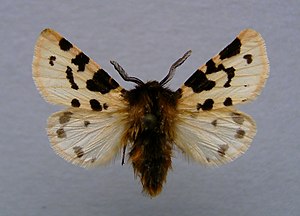Ocnogyna zoraida
| Ocnogyna zoraida | ||||||||||||
|---|---|---|---|---|---|---|---|---|---|---|---|---|

Ocnogyna zoraida , male |
||||||||||||
| Systematics | ||||||||||||
|
||||||||||||
| Scientific name | ||||||||||||
| Ocnogyna zoraida | ||||||||||||
| ( Graslin , 1837) |
Ocnogyna zoraida is a butterfly ( moth ) from the subfamily of the bear moth (Arctiinae).
features
butterfly
The moths have a wingspan of 25 to 36 millimeters in the males. Their forewing upper side has a creamy white, light pink or brownish pink base color, from which large black spots stand out, which extend from the front edge to the median vein . Sometimes the spots are banded or scattered individually over the wing surface. The upper side of the hind wing is also creamy white to light pink or brownish pink in color and provided with small black spots. The undersides of all wings depict the colors and patterns of the upper sides in a weakened intensity. There is a strong sexual dimorphism between the two sexes . The wings of the females are greatly reduced, the body is longer and heavier than that of the male. This means that you are only able to fly to a limited extent. Their wingspan reaches a length of 15 to 26 millimeters. Thorax and abdomen are hairy, woolly, reddish brown. The antennae of the males are ciliate on both sides, those of the females are thread-shaped and slightly comb-toothed.
Caterpillar
The caterpillars are hairy and have black-brown warts on each segment. Young animals have light reddish brown hair. In fully-grown caterpillars, the hairs are thick and blackish. Usually a light back line stands out.
Distribution, subspecies and occurrence
The species is locally distributed on the Iberian Peninsula as well as in southern France . It prefers to colonize grasslands , mountain slopes and rocky terrain up to higher mountain ranges. The subspecies Ocnogyna zoraida hemigena occurs in the Pyrenees .
Way of life
The moths live from April to early August, depending on the altitude. The males appear in artificial light sources at night . After mating, the females lay the yellowish colored eggs in a large, loose clutch. The caterpillars develop from May to September. They hide under stones and leaves during the day, are nocturnal and have a polyphagous diet . The main food plants are the leaves of plantain ( Plantago ), yarrow ( Achillea ), dandelion ( Taraxacum ), dock ( Rumex ), nettle ( Urtica ), sage - ( Salvia ), tragacanth - ( Astragalus ), bedstraw ( Galium ) and gorse species ( Ulex ). Pupation takes place in a cocoon on the ground between roots and stones. The species overwinters as a pupa .
Individual evidence
- ↑ a b c d Josef J. de Freina, Thomas J. Witt: Noctuoidea, Sphingoidea, Geometroidea, Bombycoidea. In: The Bombyces and Sphinges of the Western Palaearctic. 1st edition. 1, EFW Edition Research & Science, Munich 1987, ISBN 3-926285-00-1 , pp. 119/120
literature
- Josef J. de Freina, Thomas J. Witt: Noctuoidea, Sphingoidea, Geometroidea, Bombycoidea. In: The Bombyces and Sphinges of the Western Palaearctic. 1st edition. 1, EFW Edition Research & Science, Munich 1987, ISBN 3-926285-00-1 , pp. 119/120
Web links
- Lepiforum eV - taxonomy and photos
- www.pyrgus.de - Butterflies and their ecology
- www.leps.it - Moths and Butterflies of Europe and North Africa
- www.lepinet.fr - Lépi Net
- funet.fi - dissemination